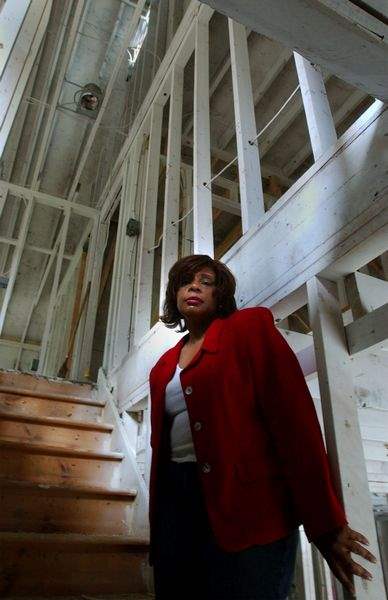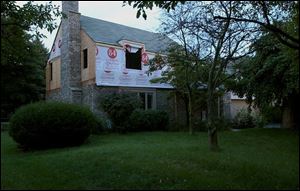
Lessons from the ashes
8/10/2003
Arvita Cleveland, inside her home, says common sense is the best tool for someone involved in a reconstruction.
lisa dutton / blade
Returning from midweek services at Cornerstone Church on the evening of April 3, Arvita Cleveland was surprised to turn on to her South Toledo street and see half a dozen fire trucks blocking the way.
Her surprise quickly turned to shock when she realized the trucks were in the driveway of her large two-story brick home and that firefighters were going in and out of the house the single mother shares with her two children.
“By that time, things were happening in slow motion. I couldn't hear anything and just kept seeing the flashing lights on the trucks,” said Ms. Cleveland.
“The fire was out but I could see the windows were knocked out and I could smell smoke.”
A firefighter on the scene told her that the fire, which had started in the kitchen, had done “well over $100,000 worth of damage.” The house had been valued at $147,000 by the Lucas County auditor's office.
Ms. Cleveland embarked that night on an odyssey of insurance claims and contractor dealings that are faced by thousands of owners each year whose homes are damaged by fire, tornadoes, wind storms, or other calamities.
Four months later, with reconstruction still under way at her home, Ms. Cleveland said she did some things right, some wrong, and learned some lessons she hopes will help others.
“Just use some good old-fashioned common sense,” she said is the No. 1 lesson she learned.
Two days after the fire, an adjuster from American Family Insurance toured the house with her, noting that smoke had destroyed most items and making arrangements for the family to stay for two weeks in a nearby motel.
The adjuster quickly estimated that repairs would take four to six months, so arrangements were made for the family to move from the motel into a condominium in the same school district.
The adjuster allocated $200,000 to repair the structure, plus money to replace the contents, a figure which Ms. Cleveland declined to disclose.
Perhaps the biggest task an owner has is to hire a contractor. Insurance industry experts, remodelers, and the Better Business Bureau suggest seeking several bids from companies that specialize in fire-restoration projects, and then checking references of those that might get the work. Get an understandable description and outline of the project and its costs before signing any forms, they said.
“What concerns me is when the consumer defers to the insurance company, who tells the contractor to put in any type of cabinet, and then the consumer is outraged because it's not at all the quality he had before,” said Richard Eppstein, president of the Better Business Bureau of Northwestern Ohio and Southeastern Michigan Inc.
“I would work with the insurance adjuster and with the remodeler to make sure you're all on the same page,” he said. “In addition to being on top of things and making sure that everything's the way it's supposed to be, I also recommend you are present as much as possible at the job site.”

Ms. Cleveland's fire-damaged house is expected to be repaired for her to move back in by October.
Ms. Cleveland said she learned those lessons the hard way.
She chose a remodeling firm because she “felt comfortable with them,” but got nervous when she didn't receive a list of allowances spelling out the quality of cabinets, flooring, and other items.
Ms. Cleveland said she became even unhappier when the firm advised her to select one type of windows to save money, but she discovered her preferred choice was cheaper.
“We never had a meeting of the minds,” she said. She quit her sales position to make sure her home was correctly re-built.
She switched to Ed Langlois, president of JBL Construction in Toledo, upon the advice of a friend. He agreed to get her into her home by Oct. 21.
“You have to build a trust with a customer,” he said. “You definitely have to do some background checking of contractors. We supply them with jobs we've done in the past.”
As for Ms. Cleveland, the most important lesson she said she learned is: “This is a major project and you've got one shot at getting it right. You can't take it back to the store to get a refund if it's not right.”
Jim Mossing, president of SMB Construction in Toledo, which does fire-restoration work, said he provides customers with an itemized list of the work and products, sometimes entailing 30 to 50 pages. Mr. Mossing is not involved in Ms. Cleveland's project.
“A customer is entitled to exactly what they had. There's an old fallacy that the insurance company is trying to rip everyone off, but that's not true,” he said.
Mr. Mossing, who is the president-elect of the Toledo Home Remodelers Association, said fire restoration is tricky because the company has to satisfy both the homeowner and the insurer.
In many cases, joint checks are issued to pay for the work, with the name of the homeowner, the remodeler, and often the mortgage holder, to ensure that everyone agrees the work has been done satisfactorily, Mr. Mossing said.
Once the overall project estimate is completed, the homeowner is asked to select cabinets, windows, and other products from catalogs and showrooms. If the owner prefers a more expensive window, for example, it can be installed and paid for by the insurance providing the total amount of the job does not exceed the estimate. If it does, the homeowner must pay the difference.
Also key to the owner of a damaged house is the coverage for replacing contents. Policies typically cover the value of the items as depreciated by age, but for an extra $30 to $80 a year the full value to replace the items can be purchased.
Ms. Cleveland last year opted for a replacement-cost provision. Her items were more easily determined by the insurance adjuster because most of the damage was from smoke, not fire. Family photos, her daughter's doll, a cherry desk and credenza, and some other items were salvageable and are being repaired, Ms. Cleveland said.
Another key provision in which homeowners policies vary is for living expenses while the damaged house is being repaired. Typically, though, it amounts to 20 percent of the value of the house, so it could be $40,000 for a $200,000 house, experts say.